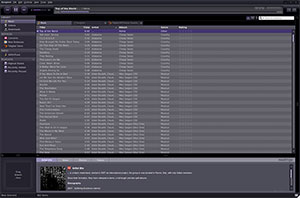
![]()
Asking a seasoned Linux user what music player you should use is akin to bringing up questions about religion or politics with your drinking buddies. A much safer strategy is, don’t ask and don’t tell. But if you insist, let me throw a suggestion into the fray.
Uncage Songbird. You might be pleasantly surprised at the melodious results. I’m not saying that Songbird is a near-perfect song collection organizer and player. It has a lot to offer, though.
Songbird is unlike so many other music players on the various Linux desktop environments. It does not mimic the look and feel of other music app interfaces.
Songbird does not fit squarely into one particular category. Instead, it is a desktop Web player, a digital jukebox and Web browser mash-up all nested in one cozy application.
It also has an unusual history. In 2010, Songbird’s developers dumped their Linux support, concentrating on maintaining the Windows and Mac versions. Official builds for the Linux platform are no longer distributed. But the Songbird community banded together to keep the Songbird for Linux version flying.
The latest release, version 1.9.3, is a 32-bit app was released earlier this month. It includes a play-queue option, a new 7Digital store and better performance. As a result, Songbird is worth using.
Feathered Features
Two of Songbird’s most prominent assets are its viability as an iTunes replacement and its lineage. It shares a family relationship with some of the prominent developers who worked on the early Mozilla Firefox project.
That gives Songbird its cross-platform roots and a striking resemblance to the user experience that comes from tabbed Web browsing.
Other features make it very suitable for organizing music library files with its Watch Folders option. Media importing and exporting is easy to do as well. Its extensive plug-in arsenal makes it very difficult to walk away from this music playing app.
Some of the many plug-ins available include song notifiers and lyric finders. You can add iPod support and BitTorrent capabilities. You can easily manage plug-ins from a drop-down menu or the Songbird add-ons website, much like you apply add-ons in the Firefox Web browser. The add-ons can integrate with other applications and services. They also can connect to external devices, change the app’s appearances and more.
Setup Simplicity
Preparing the app is very low-key. You get an assistant-driven automatic setup on the first run. It steps you through options to import all found titles or not to import.
Recommended add-ons are bundled in the installation package to extend Songbird’s basic functionality. This lets you customize your media player experiences. All are pre-checked. Uncheck the ones you do not want.
These add-ons are: LastFM, MashTape, Coincerts, New Releases, integration with 7Digital Music Store, Shoutcast Radio and Gracenote Metadata Lookup Provider.
The 7Digital tie-in is a nice touch for certain users. This service is based in Great Britain. All the pricing is in British pound. But users who wouldn’t find that convenient should uncheck this add-on option during installation to save some space. Or you can go to the Tools/Options menu and select the Add-ons panel to disable or uninstall 7Digital or other add-ons.
Can You Say ‘Customize?’
Songbird’s customization extends far beyond the large collection of plugins. Songbird lets users dock the menu bar at the top or the bottom of the application’s window.
Songbird installed on my Linux Mint 12 desktop with a default bland look. If its starkness is too unappealing, select from a hefty supply of “feathers,” or skins, to make it look however you like. These install the same way as you add plug-ins. Just download and enable your choices.
Songbird has no tray icon, however. At first blush, this looks like a glaring design flaw that impedes unfettered access to controlling music playing out of site while you do other computing tasks.
But it has a Mini player mode in the View menu that sort of makes up for the lack of a tray icon. Mini Mode hides the Songbird window and reduces the running app to what is essentially a floating toolbar. From it you can access player controls or return to its Main Player mode.
Look and Feel
Songbird’s user interface, once you get beyond its initial barren color scheme, has an unfinished look to it. It comes with very small fonts and no handy way to enlarge the view. On my large monitor, the text easily gets lost on the screen. The white font color against a striated or two-tone gray background grid makes it a bit easier to see, but not much.
Ditto for the small controls. The upside of this tiny design is lots of content is conveniently crammed into the app window.
Each service or feature in Songbird opens into a tabbed window. You can easily move around everything you are doing without having to open and close your places.
Bouncing Around
Below this listing you find the expected main audio playback controls. These include previous/play/pause, next, volume, track progress, scale rating and shuffle/repeat switches. On the left, a sidebar provides quick access to Songbird’s collection management categories: Library, Downloads, Concerts, Radio, Stores, Playlists.
Under the sidebar is a small window to downloaded album artwork for the currently playing song. If none is available, drag any picture onto that area from your own picture collection stored on the computer.
The Song Library section displays your complete music collection. This listing is split into several areas: Genre, Artist, Album, the actual songs (depending on what you choose on the first three categories) and information provided by the mashTape plugin.
Much Mashability
The mashTape feature is unusual for a music management app. Still, it is very useful. When you play a song, Songbird grabs information from the Internet and slices it up onto five tabs: Artist Info, Reviews, News, Photos and Videos. This does nothing to enhance the actual audio playback.
But it does volumes in adding to your music knowledge. You can eyeball points of interest about the artists, view photos from their concerts, read opinions or get the latest news. You can also watch related YouTube videos without ever leaving the Songbird interface. This feature is somewhat related to the Bookmark category in the song library.
This Bookmarks feature lets you use Songbird the way you would a Web browser to return to information centers on your favorite tracks. It becomes a tool to cruise the Internet in search of more stuff than music sales and cover details. You can track down histories of the albums and the performers. You can also keep tabs on upcoming concerts and such.
Bottom Line
Songbird is not a simple, light audio player. It offers a full-flight musical experience plus video playback that draws high-resource consumption. I’m not saying that it impedes your system’s performance. That depends on your hardware and how much of a power user you are.
Songbird uses the Gstreamer playback framework. This ensures a seamless playback for a variety of audio formats and radio stream sources. Overall, it is a good choice for managing and playing your media collection.























































I refuse to support any program that openly refuses to support my platform of choice. In my opinion, by dropping Linux support you turned your back on the community that got you where you are in the first place. So as far as I am concerned, and since there are much better solutions already available for Linux, Songbird can die a slow and excruciating death.